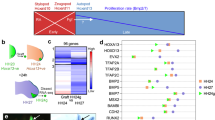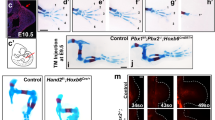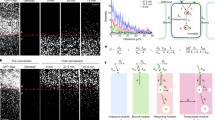Abstract
Limb development requires the formation of a proximal–distal axis perpendicular to the main anterior–posterior and dorsal–ventral body axes. The secreted signalling proteins Decapentaplegic and Wingless act in a concentration-dependent manner to organize the proximal–distal axis. Discrete domains of proximal–distal gene expression are defined by different thresholds of Decapentaplegic and Wingless activities. Subsequent modulation of the relative sizes of these domains by growth of the leg is required to form the mature pattern.
This is a preview of subscription content, access via your institution
Access options
Subscribe to this journal
Receive 51 print issues and online access
$199.00 per year
only $3.90 per issue
Buy this article
- Purchase on Springer Link
- Instant access to full article PDF
Prices may be subject to local taxes which are calculated during checkout







Similar content being viewed by others
References
Brook, W. J., Diaz-Benjumea, F. J. & Cohen, S. M. Organizing spatial pattern in limb development. Annu. Rev. Cell Dev. Biol. 12, 161–180 (1996).
Lawrence, P. A. & Struhl, G. Morphogens, compartments and pattern: lessons from Drosophila? Cell 85, 951–961 (1996).
Diaz-Benjumea, F. J. & Cohen, S. M. Interaction between dorsal and ventral cells in the imaginal disc directs wing development in Drosophila. Cell 75, 741–752 (1993).
Basler, K. & Struhl, G. Compartment boundaries and the control of Drosophila limb pattern by hedgehog protein. Nature 368, 208–214 (1994).
Tabata, T. & Kornberg, T. Hedgehog is a signalling protein with a key role in patterning Drosophila imaginal discs. Cell 76, 89–102 (1994).
Williams, J. A., Paddock, S. w., Vorwerk, K. & Carroll, S. B. Organization of wing formation and induction of a wing-patterning gene at the dorsal/ventral compartment boundary. Nature 368, 299–305 (1994).
Irvine, K. & Wieschaus, E. fringe, a boundary specific signalling molecule, mediates interactions between dorsal and ventral cells during Drosophila wing development. Cell 79, 595–606 (1994).
Kim, J., Irvine, K. D. & Carroll, S. B. Cell recognition, signal induction and symmetrical gene activation at the dorsal/ventral boundary of the developing Drosophila wing. Cell 82, 795–802 (1995).
Diaz-Benjumea, F. J. & Cohen, S. M. Serrate signals through Notch to establish a Wingless-dependent organizer at the dorsal/ventral compartment boundary of the Drosophila wing. Development 121, 4215–4225 (1995).
Zecca, M., Basler, K. & Struhl, G. Sequential organizing activities of engrailed, hedgehog and decapentaplegic in the Drosophila wing. Development 121, 2265–2278 (1995).
Nellen, D., Burke, R., Struhl, G. & Basler, K. Direct and long-range action of a Dpp morphogen gradient. Cell 85, 357–368 (1996).
Lecuit, T. et al. Two distinct mechanisms for long-range patterning by Decapentaplegic in the Drosophila wing. Nature 381, 387–393 (1996).
Singer, M. A., Penton, A., Twombly, V., Hoffmann, F. M. & Gelbart, W. M. Signaling through both type I Dpp receptors is required for anterior-posterior patterning of the entire Drosophila wing. Development 124, 79–89 (1997).
Neumann, C. J. & Cohen, S. M. Ahierarchy of cross-regulation involving Notch, wingless, vestigal and cut organizes the dorsal/ventral axis of the Drosophila wing. Development 122, 3477–3485 (1996).
Zecca, M., Basler, K. & Struhl, G. Direct and long-range action of a Wingless morphogen gradient. Cell 87, 833–844 (1996).
Neumann, C. J. & Cohen, S. M. Long-range action of Wingless organizes the dorsal–ventral axis of the Drosophila wing. Development 124, 871–880 (1997).
Brook, W. J. & Cohen, S. M. Antagonistic interactions between Wingless and Decapentaplegic responsible for dorsal–ventral pattern in the Drosophila leg. Science 273, 1371–1377 (1996).
Jiang, J. & Struhl, G. Complementary and mutually exclusive activities of Decapentaplegic and Wingless organize axial pattern during Drosophila limb development. Cell 86, 401–409 (1996).
Penton, A. & Hoffmann, F. M. Decapentaplegic restricts the domain of wingless during Drosophila limb patterning. Nature 382, 162–165 (1996).
Couso, J. P., Bate, M. & Martinez Arias, A. A wingless -dependent polar coordinate system in the imaginal discs of Drosophila. Science 259, 484–489 (1993).
Struhl, G. & Basler, K. Organizing activity of wingless protein in Drosophila. Cell 72, 527–540 (1993).
Diaz-Benjumea, F. J., Cohen, B. & Cohen, S. M. Cell interactions between compartments establishes the proximal–distal axis of Drosophila limbs. Nature 372, 175–179 (1994).
Held, L. I. J., Heup, M. A., Sappington, J. M. & Peters, S. D. Interactions of decapentaplegic, wingless and Distal-less in the Drosophila leg. Wilhelm Roux Arch. Dev. Biol. 203, 310–319 (1994).
Campbell, G., Weaver, T. & Tomlinson, A. Axis specification in the developing Drosophila appendage: the role of wingless, decapentaplegic, and the homeobox gene aristaless. Cell 74, 1113–1123 (1993).
Cohen, S. M., Brönner, G., Küttner, F., Jürgens, G. & Jäckle, H. Distal-less encodes a homoeodomain protein required for limb development in Drosophila. Nature 338, 432–434 (1989).
Mardon, G., Solomon, N. M. & Rubin, G. M. dachshund encodes a nuclear protein required for normal eye and leg development in Drosophila. Development 120, 3473–3486 (1994).
Hoodless, P. A. et al. MADR1, a MAD-related protein that functions in BMP2 signaling pathways. Cell 85, 489–500 (1996).
Wiersdorff, V., Lecuit, T., Cohen, S. M. & Mlodzik, M. Mad acts downstream of the Dpp receptors and reveals differential requirement for dpp signaling between initiation and propagation of morphogenesis in the Drosophila eye. Development 122, 2153–2162 (1996).
Theisen, H., Haerry, T. E., O'Connor, M. B. & Marsh, J. L. Developmental territories created by mutual antagonism between Wingless and Decapentaplegic. Development 122, 3939–3948 (1996).
Jiang, J. & Struhl, G. Protein kinase A and Hedgehog signaling in Drosophila limb development. Cell 80, 563–572 (1995).
Lepage, T., Cohen, S. M., Diaz-Benjumea, F. J. & Parkhurst, S. M. Signal transduction by cAMP-dependent protein kinase A in Drosophila limb patterning. Nature 373, 711–715 (1995).
Li, W., Ohlmeyer, J. T., Lane, M. E. & Kalderon, D. Function of protein kinase A in Hedgehog signal transduction and Drosophila imaginal disc development. Cell 80, 553–562 (1995).
Pan, D. J. & Rubin, G. Protein kinase and hedgehog act antagonistically in regulating decapentaplegic transcription in Drosophila imaginal discs. Cell 80, 543–562 (1995).
Gurdon, J. B., Mitchell, A. & Mahoney, D. Direct and continuous assessment by cells of their position in a morphogen gradient. Nature 376, 520–521 (1995).
Gurdon, J. B., Harger, P., Mitchell, A. & Lemaire, P. Activin signalling and response to a morphogen gradient. Nature 371, 487–492 (1994).
Riese, J. et al. LEF-1, a nuclear factor coordinating signal inputs from wingless and decapentaplegic. Cell 88, 777–787 (1997).
Laufer, E., Nelson, C. E., Johnson, R. L., Morgan, B. A. & Tabin, C. Sonic hedgehog and Fgf-4 act through a signalling cascade and feedback loop to integrate growth and patterning of the developing limb bud. Cell 79, 993–1003 (1994).
Niswander, L., Jeffrey, S., Martin, G. R. & Tickle, C. Apositive feedback loop coordinates growth and patterning of the vertebrate limb. Nature 371, 609–612 (1994).
Yang, Y. & Niswander, L. Interaction between the signalling molecules WNT7a and SHH during vertebrate limb development: dorsal signals regulate anteroposterior patterning. Cell 80, 939–947 (1995).
Crossley, P. H., Minowada, G., MacArthur, C. A. & Martin, G. R. Roles for FGF-8 in the induction, initiation and maintenance of chick limb development. Cell 84, 127–136 (1996).
Parr, B. A. & McMahon, A. Dorsalizing signal Wnt-7a required for normal polarity of A/P and D/V axes on mouse limb. Nature 374, 350–353 (1995).
Niswander, L., Tickle, C., Vogel, A., Booth, I. & Martin, G. R. FGF-4 replaces the apical ectodermal ridge and directs outgrowth and patterning of the limb. Cell 75, 579–587 (1993).
Cohn, M. J., Izpisua-Belmonte, J. C., Abud, H., Heath, J. K. & Tickle, C. Fibroblast growth factors induce additional limb development fro the flank of chick embryos. Cell 80, 739–746 (1995).
Ruel, L., Pantesco, V., Lutz, Y., Simpson, P. & Bourouis, M. Functional significance of a family of protein kinases encoded at the shaggy locus in Drosophila. EMBO J. 12, 1657–1669 (1993).
Vachon, G. et al. Homeotic genes of the Bithorax complex repress limb development in the abdomen of the Drosophila embryo through the target gene Distal-less. Cell 71, 437–450 (1992).
Panganiban, G., Sebring, A., Nagy, L. & Carroll, S. B. The development of crustacean limbs and the evolution of arthropods. Science 270, 1363–1366 (1995).
Acknowledgements
We thank G. Struhl, K. Basler and K. Cadigan for fly strains; G. Panganiban and G.Mardon for antibodies; and M. Averof, W. Brook, J. Royet and K. Weigmann for suggestions on the manuscript.
Author information
Authors and Affiliations
Corresponding author
Rights and permissions
About this article
Cite this article
Lecuit, T., Cohen, S. Proximal–distal axis formation in the Drosophila leg. Nature 388, 139–145 (1997). https://doi.org/10.1038/40563
Received:
Accepted:
Issue Date:
DOI: https://doi.org/10.1038/40563
This article is cited by
-
Characterizing Hox genes in mayflies (Ephemeroptera), with Hexagenia limbata as a new mayfly model
EvoDevo (2022)
-
Extensive loss of Wnt genes in Tardigrada
BMC Ecology and Evolution (2021)
-
Tracing the origin of hair follicle stem cells
Nature (2021)
-
Wg secreted by conventional Golgi transport diffuses and forms Wg gradient whereas Wg tethered to extracellular vesicles do not diffuse
Cell Death & Differentiation (2021)
-
FoxB, a new and highly conserved key factor in arthropod dorsal–ventral (DV) limb patterning
EvoDevo (2019)
Comments
By submitting a comment you agree to abide by our Terms and Community Guidelines. If you find something abusive or that does not comply with our terms or guidelines please flag it as inappropriate.



